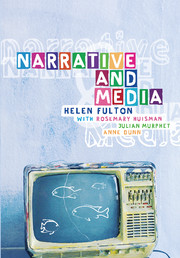Book contents
- Frontmatter
- Contents
- Figures and tables
- Contributors
- Acknowledgements
- 1 Introduction: the power of narrative
- Part 1 The basics of narrative theory
- Part 2 Film as narrative and visual mode
- 4 Stories and plots
- 5 Narrative time
- 6 Narrative voice
- 7 Point of view
- 8 Novel to film
- 9 Film narrative and visual cohesion
- Part 3 Television: narratives and ideology
- Part 4 Radio and print journalism
- Part 5 Popular print culture
- Glossary
- Bibliography
- Index
9 - Film narrative and visual cohesion
Published online by Cambridge University Press: 05 June 2012
- Frontmatter
- Contents
- Figures and tables
- Contributors
- Acknowledgements
- 1 Introduction: the power of narrative
- Part 1 The basics of narrative theory
- Part 2 Film as narrative and visual mode
- 4 Stories and plots
- 5 Narrative time
- 6 Narrative voice
- 7 Point of view
- 8 Novel to film
- 9 Film narrative and visual cohesion
- Part 3 Television: narratives and ideology
- Part 4 Radio and print journalism
- Part 5 Popular print culture
- Glossary
- Bibliography
- Index
Summary
In the previous chapter, I discussed ways in which the structures of film narrative are able to create meanings, themes and concerns that could be different from those expressed in a corresponding novel. In this chapter, further examples from the two films The Lord of the Rings: The Fellowship of the Ring and The English Patient will focus mainly on tenor and mode and how they are realised in film, particularly through sound, character, focalisation and cohesion. By examining the technical production of these effects, we can see how they provide complex sites of signification for viewing audiences.
Sound
The sound of a film is one of its most versatile signifiers, since it contributes to field, tenor and mode as a powerful creator of meaning, mood and textuality. Diegetic sounds are those that belong to the on-screen ‘reality’, able to be heard by the characters on screen, such as dialogue, sound effects (the striking of the staff on the bridge) and ambient noise (the noise of the sandstorm in the desert). Non-diegetic sounds come from outside the filmic world, and are not ‘heard’ by the characters. These conventionally include soundtrack music and voice-overs.
While dialogue clearly contributes to the tenor of a film, as the main means by which relations between characters and their attitudes to each other are constructed, sound effects and ambient noise, over-determined by technology, help to construct the semantic field.
- Type
- Chapter
- Information
- Narrative and Media , pp. 108 - 122Publisher: Cambridge University PressPrint publication year: 2005
- 3
- Cited by

